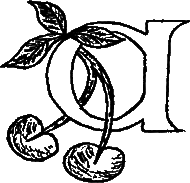
Apricot Folk - Ritual Dancing Guide
A Brief History
The Morris
Longsword
A Brief History
| ORIGINS AND EARLY HISTORY The current tradition of Morris Dancing is the result of more than 500 years of the evolution of a dance. Morris Dancing was well known in England before the Spanish Armada (1588), the Gunpowder Plot (1605) and the Wars of the Roses. It is likely that the term ‘morris’ developed from the French word morisque which means ‘a dance’. This became morisch in Flemish, and then the English moryssh, then moris and finally morris. In the 15th century, Flanders was an innovative cultural centre and strongly influenced European culture in general. |
|||||||||||||||||||||
| The earliest reference to a performance of morris
dancing in England is in London on 19th May 1448 when
“Moryssh dancers were paid 7 shillings (35p) for their
services” . By Elizabethan times it was already considered
to be an ancient dance and it is referred to in a number of
early plays, many of which called for a dance or jig to be
performed by the leading actor. One of the most popular
actors of the time was Will Kemp, and for a wager, he danced
all the way from London to Norwich. This was during Lent
1599 when the roads would be extremely bad and it became
known as The Nine Daies Wonder though he actually started
on the first Monday in Lent and did not arrive until Easter. |
 |
||||||||||||||||||||
| Throughout its history in England, morris
dancing has been through many manifestations. 500 years ago
it was a dance for one or two; today it is for four or more
and accounts of morris dancing can be found throughout the
nation, making it an English phenomenon. In particular
morris dancing was a feature of the Cotswold Whitsun ales
when each community held an elaborate procession and
carnival ceremonial. There would be village games, hoisting of a maypole, choosing the lord and lady of the May, a wooden horse on which people rode or paid a forfeit, setting up of a green bower (bar) for the sale of ale specially brewed by churchwardens to raise money for the church, a feast in a local barn, carrying of a specially baked cake, and a procession of morris dancers and various other characters such as a jack-in-the-green or a fantastically dressed man-woman, During the 19th century most of these revelries died out because of declining interest by the local communities and partly because of ‘disorderliness’ The emphasis was on the ceremonial rather than the dancing but in most cases all that has survived is the dancing. During the 19th century, various other factors such as the loss of patronage form the gentry, changing attitudes, the Industrial Revolution resulting in migration to the towns and abroad together with the growth of other leisure pursuits resulted in the decline of morris dancing, though it was kept alive in some villages by those who had it ‘in their blood’. It was towards the end of the 19th century that the cult of ‘Merrie England’ arose and in connection with this, a Warwickshire entrepreneur, D’Arcy Ferris from Bidford on Avon, recruited and paid a team of morris dancers which he called ’The Shakespearean Bidford Morris Dancers’ to perform at ‘Old English Revels’ and pageants in local towns. Morris Dancers were again in demand for Queen Victoria’s Golden Jubilee in 1887 and in March 1899. Percy Manning asked dancers from Headington Quarry, Oxford, to perform at a lecture on old customs he was giving at Oxford’s Corn Exchange. The exodus of men to fight in World War I also contributed to the decline of morris dancing. 1899 AND ALL THAT The village of Headington Quarry, near Oxford, was established because of the stone quarries and most of the men were involved in seasonal work such as quarrying, brickmaking and building. This was dependant on the weather so it was not unusual for men to be laid off for several weeks in bad weather. Morris dancing formed a useful addition to their income in what was a fairly poor community. They normally danced at Whitsun, but the weather at Christmas 1899 was particularly bad and some of the men had earned no money for three weeks so they danced round Headington on Boxing Day. |
|||||||||||||||||||||
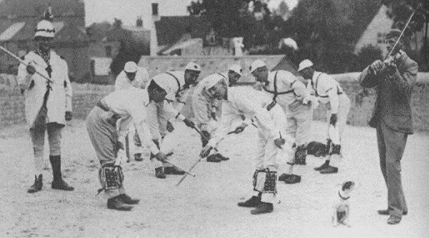 Headington Quarry Morris men dancing 'Bean Setting' in 1899. with William Kimber playing fiddle |
It was on this occasion that they were seen by Cecil Sharp who was staying with his mother-in-law at Sandfield Cottage on the London Road, Headington. William Kimber, who worked for Knowles the builders saw her about alterations to the house and promised the morris dancers would call at her cottage next time they danced . Cecil Sharp was a music teacher from London. He found the tunes interesting and noted them from William Kimber, the leader and musician. Sharp later became a great folk music collector and in 1911 formed the English Folk Dance Society which amalgamated with the Folk Song Society in 1932 to become the English Folk Dance and Song Society. | ||||||||||||||||||||
In 1905 the suffragettes Mary Neal and Emmeline Pethick were running a club for girls working in the London West End dress trade. This Esperance Working Girls Club allowed the girls an escape from the hard daily life and included activities such as singing, games and sports. They had already learnt folk songs and Mary Neal asked Cecil Sharp if there were any English dances they could learn. Sharp arranged for William Kimber and dancers from Headington to come to London and teach the girls some of the dances. In April 1906 they gave their first display at the small Queen’s Hall. Sharp published the Morris Book Part One in 1907 followed by part Two in 1909. In 1910, Mary Neal published the first Esperance Morris Book containing folk dances, songs and morris dances. As the folk dances and songs became popular, their use in schools was encouraged by the Board of Education. Much of the teaching of morris dancing from this time until the 1930s took place in country dance clubs everything being taught directly from Sharp’s books. In 1924 and in later years members of the Cambridge Morris Men (as The Travelling Morrice) toured some of the villages Sharp had visited and met many of the old dancers who taught them more dances, tunes and steps. In 1934 six of these sides became founder members of the Morris Ring, the oldest morris organisation in England. The other two organisations, the Morris Federation and Open Morris include women in their membership and were formed after World War II. WHAT DOES IT ALL MEAN? No one knows for sure what all the trappings and the characters in the morris dances mean. Here are some suggestions -
All ritual dances throughout the ages and throughout the world seem to have three features in common: · they consist of visits from place to place at certain times of the year · their purpose is to bring good luck · the performers are disguised in some way and if the disguise is broken the luck is broken. |
|||||||||||||||||||||
.jpg) Headington Quarry Morris Men |
MORRIS SIDES AND STYLES Most contemporary morris sides have been formed in the last 80 years. Each club usually has a Squire who is responsible for the performances and leads the side, a Foreman or Captain who teaches the dances and a Bagman who acts as the secretary. Sides generally practise in the winter months and perform in the summer. Morris dancing means different things to different people and is usually taken to include dances with sticks, handkerchiefs or swords as well as encompassing other styles of ceremonial dance, together with mummers plays and other calendar customs. |
||||||||||||||||||||
|
COTSWOLD The most widespread style seen today is often called Cotswold Morris and was collected from the South Midlands, an area including Gloucestershire, Oxfordshire, Northamptonshire, and Warwickshire but extending beyond these areas. These dances are usually performed in sets of 6 or 8 dancers and are distinguished by the dancers waving handkerchiefs, clashing sticks or, occasionally handclapping. There are also solo or paired dances. The use of handkerchiefs dates from Shakespearean times and sticks from the 16th century. Each side has a different costume usually consisting of a white shirt, white trousers or black breeches and bell pads worn on the shin. A coloured baldrick may be worn across the chest with rosettes. Most sides will also wear a badge or emblem signifying their place of origin. |
.jpg) |
||||||||||||||||||||
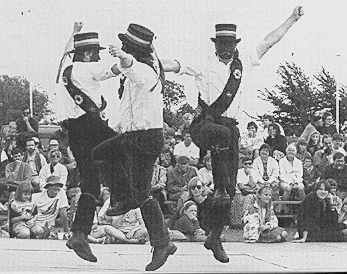 Seven Champions Molly Dancers, Kent |
MOLLY DANCES These developed in East Anglia and were performed in January as part of the Plough Monday celebrations when it was the custom for farmhands to take a plough round the local villages and if payment (for beer and food) was not forthcoming they would cut a furrow across the householder’s front lawn. The figures of the dances are based on local country dances and are performed in vigorous style. Costumes are very individualistic but largely based on working outdoor clothes and hobnailed boots. Dancers may have their faces blackened or otherwise disguised. Disguising the face in this way is well-known in English social history as men wishing to carry out certain activities (such as smuggling and morris dancing) would black their faces to avoid recognition. |
||||||||||||||||||||
|
WELSH BORDER The border counties of Herefordshire, Worcestershire and Shropshire developed their own style of dance which was simpler in form than those of the south Midlands. It has more vigorous stepping, robust sick clashing, loud shouting and is danced in sets of 4, 6, 8 or more dancers. The costume will often include a raggy jacket with small pieces of cloth (or tatters) sewn on it. Sometimes it may be a formal tail coat. Like Molly dancers, they will usually disguise their faces, some modern sides even wearing masks. Originally the music would have been an concertina or melodeon, but is now more often a big band including melodeos, fiddles, brass and percussion. |
 Armalegon Border Side |
||||||||||||||||||||
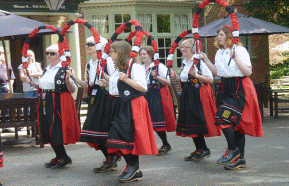 Cockleshell Clog a North West Border side with garlands |
NORTH WEST CLOG MORRIS This originates from the industrial towns of Cheshire and Lancashire. The dances involve much stepping and are best performed with military precision.. It may take the form of a procession when a few figures will be performed and these are repeated a bit further along the street. Or they may be danced on the spot in which case the team will be a multiple of 4. The dancers will often carry sticks (originally bobbins) or slings (semi-flexible rope). A number of north-west dances also make use of garlands (semi-circular hoops, often decorated with flowers). Costumes tend to be striking and footwear will usually be clogs with irons nailed to the soles and heels. The rhythm of the dance is accentuated by the clogs. There is a conductor who controls the dance from outside the set and will notify dancers and musicians of changes by blowing a whistle. The Derbyshire villages of Winster and Tidesdale have dances similar to north-west morris but which include characteristics of Cotswold dances such as handkerchiefs and shoes. |
||||||||||||||||||||
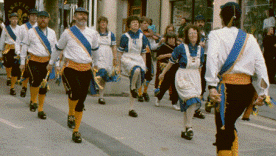 Wakefield Morris a North West Border side |
|||||||||||||||||||||
|
LONGSWORD The longsword dance, also known as hilt-and-point is to be found in Yorkshire. It is performed by 6 or 8 dancers linked together in a circle by swords. Each sword is about 1 metre long and usually made of steel with no point or cutting edge and a wooden handle. Longsword dancing is well documented in Europe where it is thought the swords had military connotations in medieval times. The dancers perform figures in which they pass over ur under the sword and sometimes the dancers work in pairs. |
 Handsworth Traditional Sword Dancers |
||||||||||||||||||||
| At the climax of the dance the swords are woven into an interlocking star or lock which is then displayed |
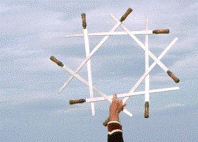 |
||||||||||||||||||||
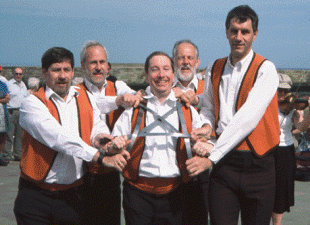 East Saxon Rapper |
RAPPER This is a version of the sword dance from mining communities of Durham and Northumberland. The sword is a flat strip of flexible or spring steel about 60cm long with a rotating handle at one end and a fixed one at the other. The sword can be bent into a complete circle and some think the swords were originally used to scrape sweat off pit ponies. The dance is for 5 dancers, often augmented by additional characters of Tommy and/or Betty. |
||||||||||||||||||||
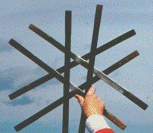
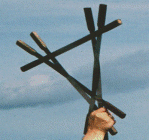 |
Rapper is the fastest of all morris dances, requiring
the least space and is the most physically demanding as some
dances require back somersaults. The costume needs to allow for the speed and agility needed to perform the dance well. It consists of hard-soled shoes, white shirts and a cummerbund, with huggers (open-ended breeches originally worn by miners. |
||||||||||||||||||||
|
OTHER CUSTOMS ASSOCIATED WITH MORRIS DANCING Mumming describes a wide range of traditional drama usually performed in the round inside a pub or outside on the road. Different areas had its own distinctive type of play and the mummers would usually wear either a disguise in the form of elaborate streamers of wallpaper, rags or news- papers which cover them from head to toe, or a costume to reflect their character. Morris dancers may perform a locally collected mumming play during the Christmas season. This is most likely to be a Hero-Combat play about good triumphing over evil and will often open with Father Christmas introducing himself as In comes I, old Father Christmas Welcome be or welcome not I hope old Father Christmas Will never be forgot. He then introduces other characters such as St George, a Turkish Knight and a Valiant Soldier. There is a fight when one of them dies and is resuscitated by a highly qualified Doctor with amazing cures. |
|||||||||||||||||||||
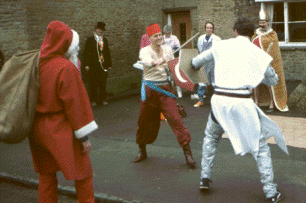 Aynho Mummers - the fight |
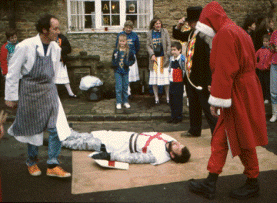 Aynho Mummers - the cure |
||||||||||||||||||||
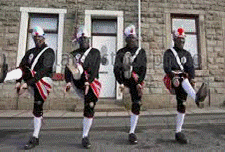 Britannia Coconut Dancers |
There are many other traditional and curious customs throughout England. The Britannia Coconut Dancers from Bacup (Lancashire), the Abbots Bromley Horn Dancers (Staffordshire) and the Minehead (Somerset) and Padstow (Cornwall) ‘Obby ;Osses are unique to their localities. Some customs such as Jack-in-the-Green celebrations in Rochester( Kent), Hastings (Sussex) and Greenwich (London) have been revived by local morris sides and as a result have developed new and interesting forms. | ||||||||||||||||||||
|
MUSIC AND MUSICIANS Historically, the Cotswold morris was accompanied by one player with a pipe and tabor. The tune would be played on a 3-holed pipe and the drum or tabor hung from the same arm was beaten with the other hand. Buy 1840 this had been superseded by the fiddle though many dancers found it difficult to dance without a separate rhythmic accompaniment. By the 1880s the melodeon and concertina were becoming widely used and later in the early 20th century, the piano-accordion also proved popular. Many other instruments can also be used as long as they are portable and loud enough. The tunes used for Cotswold morris dancing come from a variety of sources. Some date from late medieval times while others were popular tunes of the 18th and 19th centuries. Each village would have individual variations of the tunes used. |
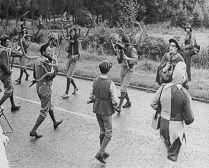 Abbots Bromley Horn Dancers 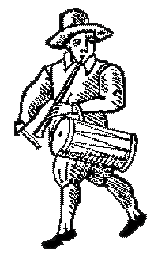 |
||||||||||||||||||||
| North west morris used more regular
and militaristic music including well-known marches such as
The British Grenadiers and Lilliburlero. In the 1800s the music would have been supplied by a fife and drum band and later a brass band. Today a mixture of brass and melodeons is likely. Rapper dances usually use jigs (6/8 tunes) played fast by a single musician. |
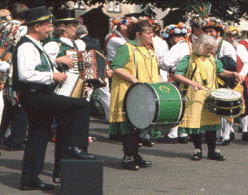 Persphone Band |
||||||||||||||||||||
 Westminster Morris beast |
FOOLS AND BEASTS The Fool plays an important part of many sides performing Cotswold morris by providing a link between the audience and the dancers. Often the best dancer in the side and would on occasion be asked to demonstrate his skill by performing a solo jig. Each Fool dresses as he wishes, but most will also carry a short stick with a pig’s bladder attached by a piece of string. If any dancer is not putting enough effort into their dancing or makes a mistake, then the Fool will encourage them to do better by whacking them with the bladder. As well as the Fool, there may be a mythical and mysterious Beast. This would usually be a Hobby Horse and they love to torment and tease the audience, especially children! The Beast likes doing all sorts of things like sunbathing and riding bicycles as well as drinking beer and eating money. |
||||||||||||||||||||
|
APPALACHIAN STEP DANCING This is really a form of step-dancing from the Appalachian Mountains in America. The Appalachian people descend from the earliest settlers from Europe and the dances may be based on ancient European dances that have been Americanised. The dancers’ shoes have metal tips and they dance on boards to give a characteristic off-beat rhythmic. |
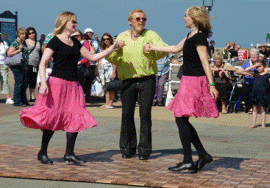 Appalachian clog dancers at Whitby |
||||||||||||||||||||
|
ACKNOWLEDGEMENTS The Morris Tradition Sean Goddard (The Morris Ring) Discovering English Folk Dance Hugh Rippon (Shire Publications) Mayday to Mummers Christine Bloxham (Wychwood Press) |
|||||||||||||||||||||